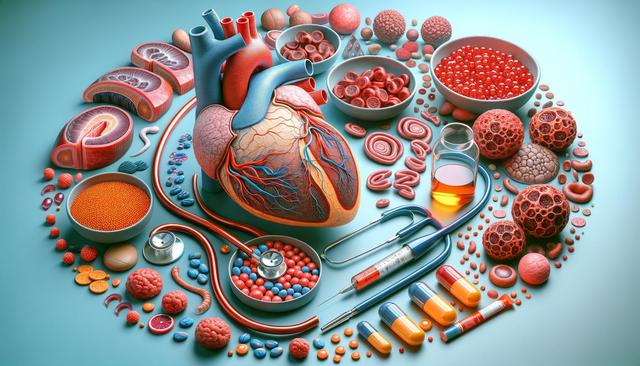What Is Amyloidosis?
Amyloidosis is a group of rare diseases that occur when an abnormal protein called amyloid builds up in organs or tissues. These amyloid deposits can interfere with the normal function of affected areas, leading to a variety of health issues. Understanding what is amyloidosis is crucial for early detection and treatment. This condition is not a single disease, but rather a group of diseases that share a common feature—amyloid accumulation. Amyloid proteins are misfolded proteins that the body cannot break down or eliminate efficiently. As a result, these proteins accumulate and disrupt normal tissue structure and function.
There are several types of amyloidosis, including AL (primary) amyloidosis, AA (secondary) amyloidosis, and hereditary forms. Each type is associated with different underlying causes and health consequences. AL amyloidosis, the most common form, is linked to bone marrow disorders. AA amyloidosis often results from chronic infections or inflammatory conditions. Genetic mutations can lead to hereditary amyloidosis, which runs in families. Early recognition of the condition and identifying the type is essential to choosing the right treatment path.
Recognizing Amyloidosis Symptoms
Amyloidosis symptoms can vary widely depending on which organs are affected. This makes diagnosis challenging and often delayed. Common signs develop gradually and may mimic those of other conditions. However, understanding the range of symptoms can help individuals seek medical attention sooner. Some general symptoms include:
- Fatigue and weakness
- Unexplained weight loss
- Swelling in the legs, ankles, or abdomen
- Shortness of breath
- Numbness or tingling in the hands and feet
When the heart is affected, symptoms may resemble heart failure, including fluid retention and irregular heartbeat. Kidney involvement can lead to protein in the urine and kidney dysfunction. Nervous system involvement may cause balance issues or tingling sensations. Because of the broad array of symptoms, amyloidosis can often be mistaken for more common ailments. This further emphasizes the importance of being aware of amyloidosis warning signs.
Early Amyloidosis Warning Signs to Watch For
Recognizing early amyloidosis warning signs can make a significant difference in outcomes. While symptoms may be subtle at first, they tend to worsen over time. Some of the initial signs that may prompt further medical investigation include:
- Persistent fatigue not relieved by rest
- Swelling without clear cause
- Changes in skin appearance or texture
- Difficulty swallowing or hoarseness
- Unusual bruising, especially around the eyes
These signs may not seem connected at first, but they can provide valuable clues when viewed together. For instance, periorbital purpura—bruising around the eyes—is a classic sign of AL amyloidosis. A thorough medical evaluation, including blood tests, imaging, and biopsies, is often needed to confirm the diagnosis. Being aware of these warning signs can prompt earlier testing and possibly slow disease progression.
Skin Manifestations and Visual Clues
In some cases, amyloidosis may present with visible skin changes. These changes, although not always present, can be an important diagnostic clue. Searching for amyloidosis skin pictures can help individuals and healthcare providers recognize these signs. Common skin-related symptoms include:
- Easy bruising, especially around the eyes
- Purplish patches or lesions
- Thickening or waxy appearance of the skin
- Small bumps or nodules under the skin
These signs may result from amyloid deposits in the blood vessels or skin tissues. Involvement of the skin can also indicate more widespread systemic disease. While skin presentations alone are not enough for diagnosis, they can support other clinical findings. Dermatologists may play a role in identifying these symptoms and guiding further testing. Visual documentation through amyloidosis skin pictures is often used in medical literature to educate professionals about these rare but telling signs.
Treatment Options and Living with Amyloidosis
The treatment for amyloidosis depends on the type and severity of the disease. In general, the goal is to reduce the production of amyloid proteins and manage organ damage. For AL amyloidosis, treatment may involve chemotherapy to target abnormal plasma cells. AA amyloidosis requires addressing the underlying inflammatory condition. In hereditary cases, genetic counseling and specific therapies may be recommended.
Supportive care is also essential. Patients may need medications to manage symptoms such as fluid retention, pain, or blood pressure issues. In some cases, organ transplants may be necessary if damage is severe. Living with amyloidosis often requires a multidisciplinary approach, involving hematologists, cardiologists, nephrologists, and other specialists. Lifestyle modifications, such as maintaining a low-sodium diet and monitoring physical activity, can also help improve quality of life.
Regular follow-ups, lab tests, and imaging are crucial to monitor disease progression and response to treatment. Support groups and counseling can assist patients and families in coping with the emotional aspects of the condition. Although amyloidosis is a serious diagnosis, advancements in treatment continue to improve outcomes for many patients.




Leave a Reply